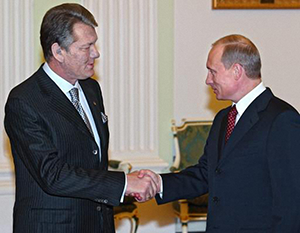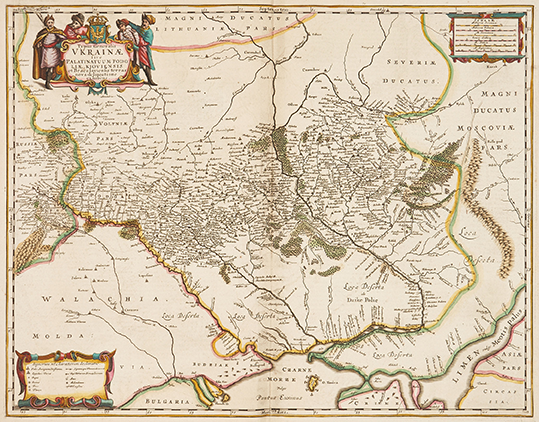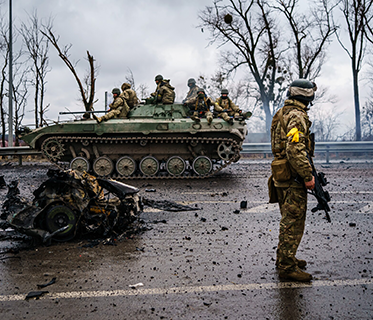UKRAINE—A BRIEF HISTORY
Published in Features, Issue 3 (May/June 2022), Volume 30By Hiram Morgan
It is not surprising that East–West relations are now convulsed by the war waged against Ukraine, as that country’s name means frontier or borderland. It is a different type of natural border from what we are used to in the West, not a channel, river, mountain range, marshland or forested terrain but a vast expanse of plain—the steppe. Once politically stabilised and populated, this march, assisted by a river system emptying into the Black Sea, became a bread basket for the world.
Establishing its sovereignty in 1991, Ukraine became Europe’s largest state. Its citizens dislike the definite article that foreigners often placed in front of it—‘the Ukraine’—as this seemed to suggest that it is not an entity of itself but merely a region, the buffer of other peoples’ territories. States, and much less nations, rarely possess natural frontiers or are discrete entities but Ukraine has nevertheless a long historical pedigree.
KYIVAN RUS’
Ukraine has its origins in the Kyivan Rus’, an Eastern Slav kingdom that adopted Orthodox Christianity and flourished in the tenth and eleventh centuries. At the western end of the Silk Road from China, Kyiv grew to a sizeable town of 40,000 inhabitants. This civilisation, swept away by the Mongol invasions, is claimed alike by Moscow, Minsk and Kyiv as the crucible out of which Russia, Belarus and Ukraine have developed.
When Mongol power waned, the area around Kyiv was overrun from the north by the duchy of Lithuania and in turn came under Poland’s influence when Lithuania united with its western neighbour, first in a dynastic marriage alliance in 1386 and then in a fuller union in 1569 ruled from Cracow. What now became the southern reaches of the Polish–Lithuanian Commonwealth were exploited by Polish landlords seeking to build up their Baltic grain trade economy. This involved expanding serfdom and increasing their cultural influence by extending Catholicism. Part of this process was the establishment of the Uniate Church in obedience to Rome but keeping its Eastern liturgy and its married priesthood.
COSSACKS

Above: Ukrainian president Viktor Yushchenko, still bearing the scars of his recent attempted poisoning, being congratulated by Russian president Vladimir Putin following his victory in the re-run election of St Stephen’s Day 2004. (EMPICS)
The backlash was led by the Zaporozhian Cossacks. These were one of two groups of self-governing soldier-settlers—the other being the more Moscow-orientated Don Cossacks—who defended the frontiers of Orthodoxy against the Crimean Tatars, a remnant of the Mongols, who were now an Islamised outlier of the Turkish Ottoman empire. The rising of 1648 was led by the Cossack hetman, Bohdan Khmelnystsky, who wreaked havoc on Polish nobles and took revenge on Jewish middlemen and Jesuit proselytisers. Defeated at Berestechko in 1651, Khmelnystsky saved himself in the 1654 treaty of Pereyaslav by switching his allegiance to Tsar Alexei. This was how Moscow acquired Kyiv and this is what makes Khmelnystsky such a controversial figure for Ukrainians, because the man who led their first putative national revolt handed them into the power of the Russians. Furthermore, though the tsars eventually whittled away the separate hetmanate constitution recognised at Pereyaslav, the Cossacks as soldiers and settlers developed a reputation as the most loyal supporters of tsarism and Orthodoxy.
The Cossack rising was the first stage in the eventual collapse of the Polish kingdom and its absorption by its Austrian, Prussian and Russian neighbours. Under Russian rule, the Kyiv region was known as ‘Little Russia’, as distinct from Great Russia and White Russia, and in the eighteenth century its boundaries were extended in wars against the Turks and Tatars to incorporate Crimea in 1783 and the Black Sea coast around Odesa in 1792. The country’s agricultural potential was obvious and quickly became the epicentre of the Black Sea grain trade, with Odesa and its free port regularly seeing half of the Russian empire’s annual wheat exports. The newly conquered area—called by Catherine the Great Novorossiya—was mostly settled by Russians and Jews and overall, in its towns especially, Russian became the dominant language.
NINETEENTH-CENTURY RUSSIFICATION
In the nineteenth century the process of Russification continued with the abolition of the local legal code, the banning of the native language in 1876 and continuous attempts to suppress the Uniate Church. In 1818 the Ukrainian language got its first grammar book, which the compiler described as that of ‘a disappearing dialect’, and in 1823 its first dictionary. More importantly, a separate identity began to emerge, led, as in other nationalist movements, by an intelligentsia interested in the folklore of the peasantry—the foremost in this case being the pastoral poet Taras Shevchencko (1814–59). To indicate separateness, these intellectuals began to employ the term Ukraina, a term available from the Middle Ages in surviving Kyivan Rus’ documents, and hence Ukrainian was coined as a neologism, because before that most inhabitants described themselves as either Orthodox, muzhik (peasant) or collectively as tuteshni (people from here). In Habsburg Galicia around Lviv the Ukrainian movement enjoyed greater success, establishing its own university and political parties, because the Austrians were less repressive and anxious to play the Ukrainians off against the Poles. When the Russian and Austrian empires collapsed at the end of the First World War, Ukrainians established short-lived governments of their own in Lviv and Kyiv but were ignored by the great powers’ map-making at Versailles.

Above: This Dutch map from 1685, based on the mid-seventeenth-century maps and descriptions by French soldier Guillaume La Vasseur de Beauplan, is interesting. It explicitly uses the term ‘Ukraine’, showing it to be already a recognised separate political entity; the insignia on the cartouche indicates that it was then still under Polish rule and the decorative figures emphasise the importance of the Cossacks. Also significant are the vast, sparsely inhabited territories in the south, bordering the Turks and Tatars, classed as loca deserta, otherwise known as ‘wild fields’. (Case Antiques)
SEPARATE REPUBLIC IN THE USSR
The devastation and depopulation in Ukraine during the First War World was the beginning of the worst period in the region’s history. After the war, whereas the Ukrainian nationalists were brutally suppressed by the Poles, in the USSR they at least had the benefit of recognition as a separate republic, and even encouragement of their culture. Stalin’s repression of intellectuals began in the late 1920s, however, and then the countryside was devastated by forced collectivisation that led to famine in 1932–3. An estimated three and a half million died in the Holodomor. The Second World War saw double that number of deaths, formal and guerrilla warfare, forced labour and the extermination of Ukraine’s Jews by the SS and their local sympathisers.
Ironically, Ukraine emerged bigger from the war—part of Galicia, annexed from Poland, the eastern tail of Czechoslovakia and bits of Romania were added. In 1954 Khrushchev transferred Crimea to it after the Tatars were deported for alleged collaboration with the Nazis. Ukraine even acquired a separate seat at the UN, which the Soviet Union had been granted, along with seats for Russia and Belarus.
In a perverse way the Soviet Union had encouraged Ukrainian nationhood, but it was by no means a foregone conclusion that Ukraine would break away when the collapse came in 1991. At this stage Ukraine was heavily Russified and had a strong concentration of Communist Party members. The explosion of the Chernobyl nuclear plant in 1986 undermined Moscow’s authority, however, and a nationalist movement, Rukh, began in Catholic Western Ukraine. When the reactionary coup against Gorbachev failed in 1991, the communists in Ukraine—still a majority in the republic’s parliament—saved themselves by opting for independence. The people themselves overwhelmingly endorsed this decision by referendum. Thereafter change was slow and life hard in what had previously been the agricultural core of the Soviet Union and the centre of much of its heavy industry. After hyperinflation, Ukraine adopted a new currency. Following piecemeal privatisation, the nomenklatura emerged as a new oligarchy, as in Russia, with the economy itself continuing to operate in a bilateral free trade arrangement with Moscow.
DISPUTED 2004 PRESIDENTIAL ELECTIONS
Since the start of this century Ukraine has diverged both politically and economically from the path that Russia has followed, becoming steadily more western-orientated, not least because of many of the actions that Russia has taken towards it. Russia became challenging and menacing, using gas supplies and prices as leverage and allegedly having candidate Viktor Yushchenko poisoned in the lead-up to the disputed 2004 presidential elections. In a sense real independence only arrived when this native-speaking Ukrainian won the re-run election on St Stephen’s Day 2004.
Yet the so-called Orange Revolution election left Ukraine divided on a north-west/south-east basis. Half of Ukraine spoke Russian as its first language, a substantial part of its Orthodox believers looked to the patriarch of Moscow as their spiritual head, and a majority of the population in the Donbas and Crimea were ethnic Russians. Yushchenko ended up an embattled, unpopular and controversial figure. The more Russia-orientated Viktor Yanukovych won the 2010 presidential election but was left having to implement policies aimed at entering an association agreement with the European Union. When he baulked at signing the ratification, he was ousted after failing to suppress a popular uprising in Kyiv known as the Maidan or Euro-Maidan protests (November 2013–February 2014).
A NATION FORGED IN WAR

Above: A Ukrainian military vehicle speeds by on a main road near Sytnyaky, west of Kyiv. (Marcus Yam/Los Angeles Times)
Russia, in danger of losing economic control over the jewel of the former Soviet Union, also faced the prospect of the expiry of a treaty enabling the use of Sevastopol as a naval base for its Black Sea fleet. As a result it immediately used the pretext of Russian regional sympathies to invade Crimea and to support separatism in the Donbas oblasts of Luhansk and Donetsk. This maskirovka operation, using a combination of special forces and irregulars, which saw over a million people displaced and an international airliner shot down, resulted in international sanctions being imposed on Russia. Yet Putin’s proxies had not been able to take the whole of the Donbas. Russian aggression had backfired—it united Russian-speakers with their fellow Ukrainians, leading in 2019 to the election of Volodymyr Zelenskyy, a Jewish political outsider, and to the historic split of the Ukrainian Orthodox Church from Moscow. Russian autocracy had forged in war a new democratic, post-industrial and wholly European nation.
Hiram Morgan lectures in history at University College Cork.
Further reading
M. Dyczok, Ukraine: movement without change, change without movement (Amsterdam, 2000).
P. Magocsi, A history of Ukraine (Toronto, 1996).
A. Reid, Borderland: a journey through the history of Ukraine (London, 1997).
This is a updated version of an article that originally appeared in HI 13.1, Jan./Feb. 2005.
















